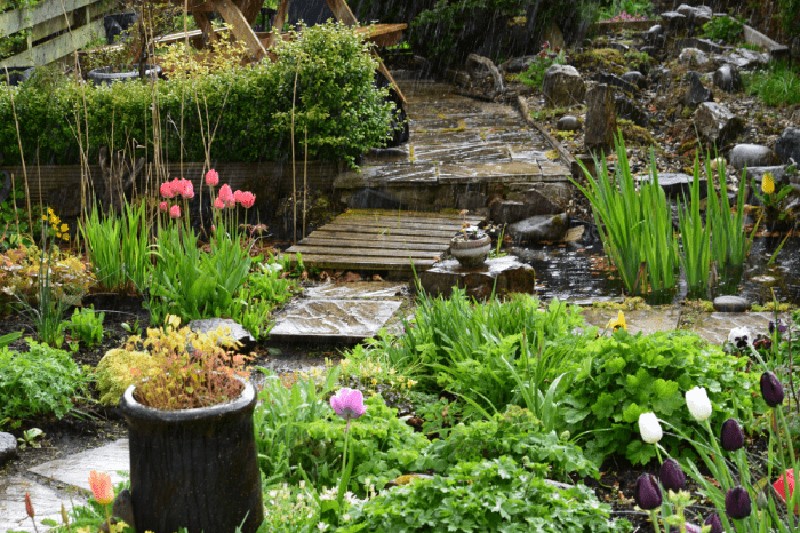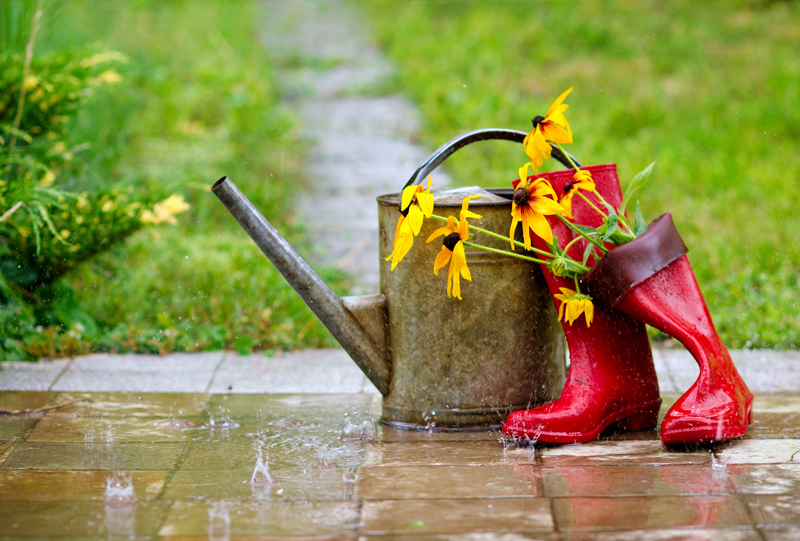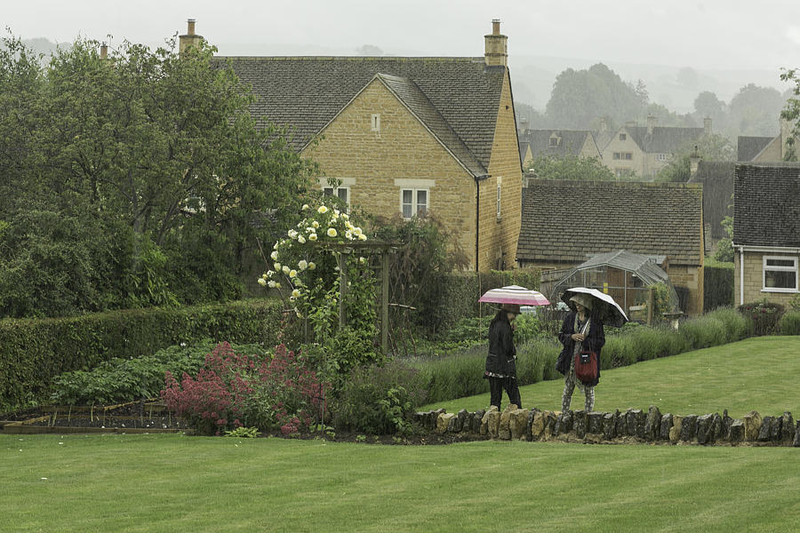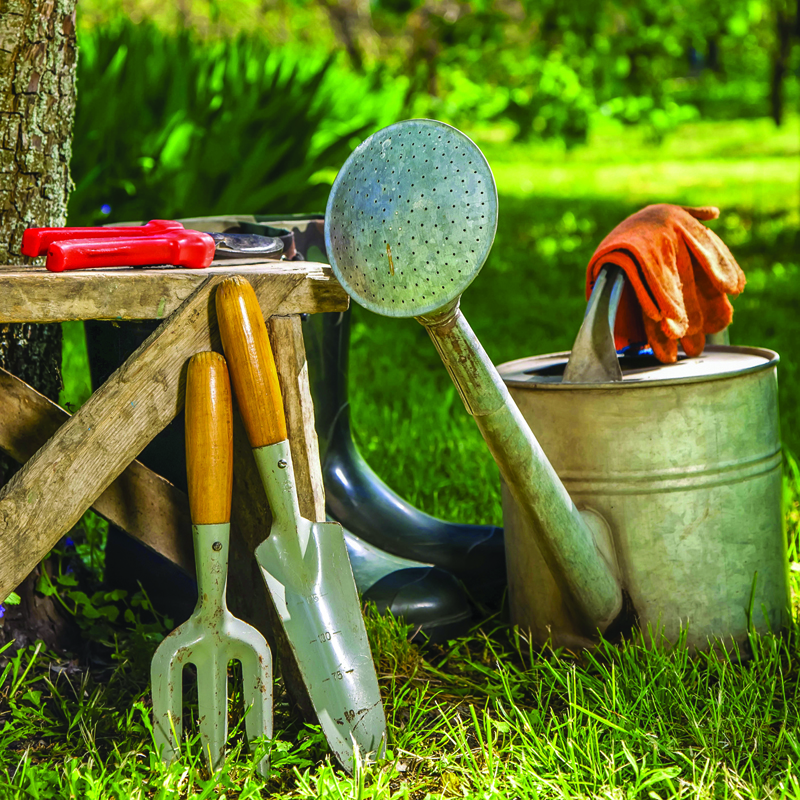Gardening in rainy days can be challenging, as the wet soil can make it difficult to work the ground and the excess moisture can lead to fungal diseases in plants. However, there are still a few things you can do to maintain your garden during rainy days:
- Mow your lawn and trim hedges, since the grass and foliage will be more pliable when wet.
- Clear away any debris, such as fallen leaves, from the garden beds to prevent fungal diseases from spreading.
- Water plants in the morning, so they have time to dry off before nightfall.
- Avoid walking on wet soil, as this can compact the soil and make it difficult for roots to penetrate.
- Use a rain gauge to measure how much rain has fallen in your area, so you can adjust your watering schedule accordingly.
- It’s important to note that some plants, such as succulents, cacti, and Mediterranean herbs, are well adapted to dry conditions and do not need extra water during rainy days.
- What to Wear for Gardening When It Rains
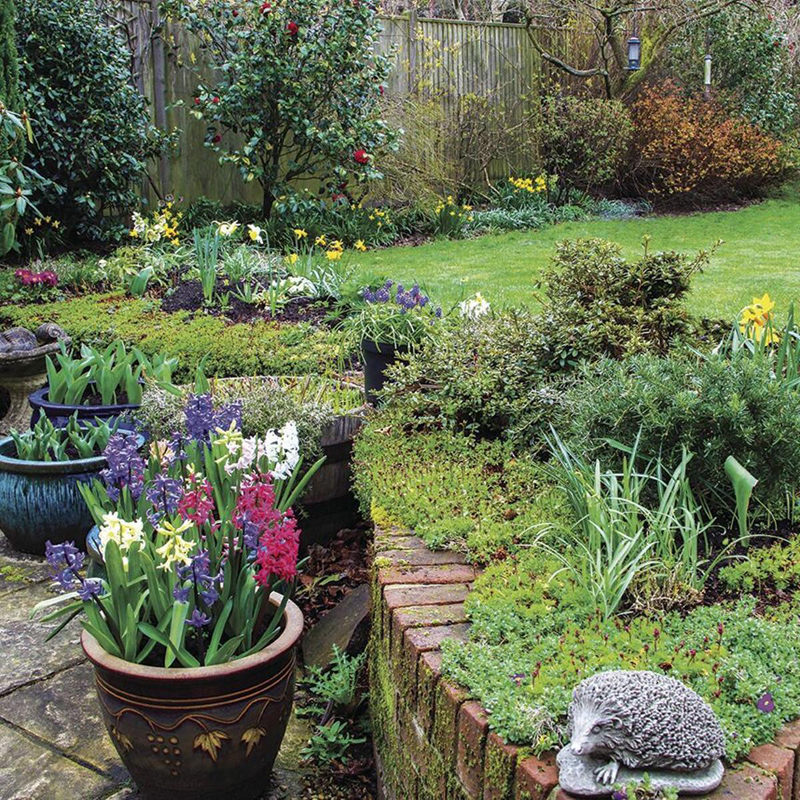
What to Wear for Gardening When It Rains
When gardening in the rain, it’s important to wear the appropriate clothing to keep yourself dry and comfortable. Here are a few suggestions for what to wear:
- Raincoat or poncho: A waterproof raincoat or poncho will keep your upper body dry while you’re working in the garden.
- Waterproof boots or shoes: Keep your feet dry with a pair of waterproof boots or shoes. Look for a pair with good traction to prevent slipping on wet ground.
- Waterproof gloves: Keep your hands dry with a pair of waterproof gloves. Look for gloves that are durable and provide a good grip.
- Waterproof pants: Waterproof pants will keep your lower body dry and they can be easily removed once you are finished with your task and back home.
- Warm clothing: Even if it is raining, temperatures can drop quickly, so dress in warm layers to keep yourself comfortable.
- Sun hat or rain hat: to protect your face and head from the rain, sun or strong winds.
It’s also a good idea to bring an umbrella or other form of shelter to protect yourself from the rain while you’re working.
How Can You Prepare Your Garden for the Rain?
Here are a few ways to prepare your garden for the rain:
- Clear debris: Clear away any debris, such as fallen leaves, from the garden beds to prevent fungal diseases from spreading.
- Drainage: Make sure that your garden beds have good drainage to prevent water from pooling. If necessary, amend the soil with organic matter or add a layer of gravel to improve drainage.
- Mulch: Apply a layer of mulch to the garden beds to help retain moisture and protect the soil from erosion.
- Watering: Make sure that your plants are well-watered before the rain arrives. This will help them to better withstand heavy rain and strong winds.
- Staking: Stake tall plants or those with large leaves to prevent them from being knocked over by strong winds.
Check the forecast: Check the weather forecast and prepare your garden accordingly. If heavy rain is expected, you may need to take additional steps to protect your plants, such as covering them with tarps or plastic sheeting.
Mow your lawn: mow your lawn before the rain arrives, so the grass can dry out and not become too long and soggy.
Take care of your tools: Clean and dry off your gardening tools before the rain arrives to prevent rust and corrosion.
Remember that heavy rain can cause soil erosion, so it’s important to take steps to protect your garden beds and plants from damage.
What Can You Do in the Rain for gardening?
Here are a few things you can do in the rain for gardening:
- Plan and organize: Use the time inside to plan and organize your garden. Make a list of plants you want to grow, design your garden layout, and research different gardening techniques.
- Start seeds: Rainy days are a great time to start seeds indoors. You can sow seeds in pots or trays and place them in a warm, bright location.
- Indoor maintenance: Take care of indoor plants, such as succulents, cacti, and tropical plants, by cleaning the leaves, repotting if necessary, and fertilizing.
- Greenhouse work: If you have a greenhouse, use the rainy weather to your advantage and tend to your plants inside.
- Clean and organize gardening tools: Rainy days are a great time to clean and organize your gardening tools, so they are ready to use when the weather clears up.
- Repair or maintain garden structures: Take advantage of the rainy weather to repair or maintain garden structures such as fences, trellises, or arbors.
- Research: Research about new plants, gardening techniques, or tools, you can use for your garden.
- Prepare your compost: Rainy days are a great time to turn your compost pile. The rain will help to moisten the materials and speed up the decomposition process.
- Remember that even though the rain may limit your outdoor gardening activities, there are still plenty of things you can do to keep your garden healthy and thriving.
What Can You Do After the Rain for gardening?
After the rain, there are several things you can do to take care of your garden:
- Check for damage: Inspect your garden for any damage caused by the rain, such as fallen branches, broken branches or stems, or washed-out soil.
- Remove debris: Remove any debris, such as fallen leaves or branches, that may have accumulated in the garden during the rain.
- Drain standing water: Look for any standing water in the garden and take steps to drain it, as this can lead to waterlogged soil and root rot.
- Aerate the soil: Aerate the soil by using a garden fork or aerator shoes to create holes in the soil, which will allow water and air to reach the roots more easily.
- Water the plants: After the rain, check the soil moisture level, if the soil is dry then water the plants, as the rain may not have provided enough water for your plants.
- Fertilize: Apply fertilizer to the plants, as the rain may have washed away some of the nutrients in the soil.
- Prune: Prune dead or damaged branches from shrubs and trees, to encourage new growth and prevent disease.
- Check for pests or diseases: After the rain, keep an eye out for any signs of pests or diseases, such as discolored leaves or mold, and take action to treat them.
- Resume normal gardening activities: Once the soil has dried out, you can resume normal gardening activities such as planting, weeding, and mulching.
- By taking care of your garden after the rain, you can help it recover quickly and maintain its beauty and health.
The basics for container gardening
Container gardening is a great way to grow plants in small spaces or when you don’t have access to a traditional garden plot. Here are the basics for container gardening:
- Choose the right container: Select containers that are the appropriate size and shape for the plants you want to grow. The container should have drainage holes to allow excess water to escape.
- Use quality potting soil: Use a good quality potting soil that is specifically formulated for container gardening. This type of soil is lightweight and well-draining, which is important for container gardening.
- Consider the light: Place containers in an area that receives the appropriate amount of light for the plants you want to grow. Most plants need at least six hours of direct sunlight per day.
- Watering: Container plants dry out faster than those in the ground, so they may need to be watered more frequently. Check the soil moisture regularly and water when the top inch of soil is dry to the touch.
- Fertilize: Container plants may need to be fertilized more frequently than those in the ground, since the nutrients in the potting soil can be quickly used up. Use a balanced, water-soluble fertilizer and follow the package instructions for application rates.
- Maintenance: Regularly check for pests and diseases, and prune and deadhead the plants as needed to keep them healthy.
- Have fun: Container gardening can be a fun and rewarding hobby, so enjoy experimenting with different plants and container combinations to create your own unique garden.
